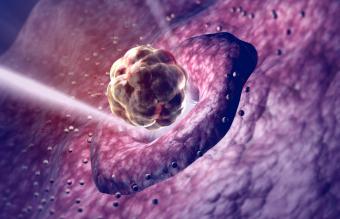
Women typically experience changes in areola when pregnant. The changes are associated with the earliest signs of pregnancy.
What Is the Areola?
The areola is skin around the nipple that is darker than the rest of the skin on the breast. The tissue contains muscle fibers that help the make the nipple erect to prepare for nursing a baby. In addition, it also contains:
- Sweat glands
- Sebaceous glands
- Glands of Montgomery
The glands of Montgomery are adapted mammary glands that release oil to lubricate the areola and the nipple during pregnancy. The lubrication helps prepare the delicate skin for nursing throughout the pregnancy. In addition, the glands help protect the area from becoming infected.
Color
The areola can be a number of different colors. The skin naturally becomes more prominent and darker during puberty. Colors may include:
- Tan
- Beige
- Pink
- Dark brown
Before a first pregnancy, the skin of the areola is most likely to be slightly darker than the surrounding breast. If a woman is not pregnant and finds that one breast has flaking skin and discoloration of the areola, a physical exam is in order. This can be a sign of a rare disease.
Paget's Disease
Paget's disease can lead to the discoloration of the areola and nipple on one breast and not the other. This condition is a type of cancer that grows specifically in this region of the body.
This rare from of cancer is named after Sir James Paget, a scientist who noticed that skin discolorations or other changes in the nipple may be an indicator of an underlying cancerous condition.
Although changes in the areola when pregnant are not associated with breast cancer, it is still advisable to have regular examinations and to report any alarming changes including flaking and peeling.
Changes in Areola When Pregnant
When a woman becomes pregnant, her body goes through many changes, including hormonal changes that help support the developing baby. Among the changes are ones that occur in the breast area, which makes perfect sense considering that this is where milk for the baby is produced. The changes occur very early in the pregnancy, making them some of the very first sign of pregnancy.
Women can expect to see the following changes in the areola during pregnancy:
- Darker color can progress throughout the pregnancy.
- Increasing diameter differs from one woman to another and it may continue gradually until labor and delivery.
- Montgomery glands become larger during pregnancy and may resemble pimples.
- Thicker skin in the areola and nipples progresses and continues after delivery.
- Nipple enlarges and becomes erect in order to prepare for nursing.
- Breasts enlarge as more estrogen and progesterone are produced, leading to expanding glandular tissue and enlarged blood vessels.
Why Changes in the Areola Occur
The changes in the areola during pregnancy occur for good reason. The Montgomery glands protect the area from infection and they provide a lubricant to prepare the skin for breastfeeding. The skin thickens to prepare for suckling, which can be very painful at first.
The darker skin on the areola provides a stark contrast, which helps the baby spot the milk source. Newborns have blurry eyesight and the prominent difference in color may help them latch on easier. Enlarged nipples are better for nursing and the thicker skin offers protection from injury. However, there are things a woman can do to prepare for breastfeeding.
Preparing for Breastfeeding
The enlarged areolas are lubricated with oil secretions from the Montgomery glands. The secretions can be augmented with a breastfeeding cream like Lansinoh. This product can help heal cracked skin and it helps to toughen the areola and nipple prior to breastfeeding. The cream does not have to be washed off before feeding. Many women use products like Lansinoh prior to giving birth. Avoid using soap directly on the areola and nipples. This can dry the skin and can wash away the protective oils secreted by the Montgomery glands.
How Long Do Changes Last?
Women can expect the areola to return to its pre-pregnancy size after they quit breastfeeding, but some do not. However, the color may lighten but it isn't likely to become as light as it was before becoming pregnant.







